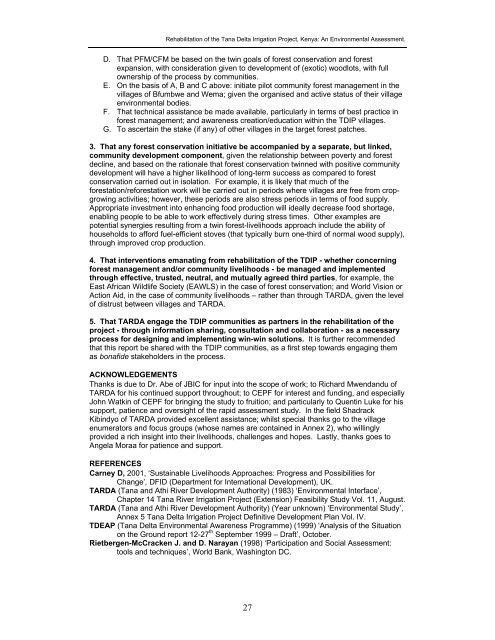Tana Delta Irrigation Project, Kenya: An Environmental Assessment
Tana Delta Irrigation Project, Kenya: An Environmental Assessment
Tana Delta Irrigation Project, Kenya: An Environmental Assessment
Create successful ePaper yourself
Turn your PDF publications into a flip-book with our unique Google optimized e-Paper software.
Rehabilitation of the <strong>Tana</strong> <strong>Delta</strong> <strong>Irrigation</strong> <strong>Project</strong>, <strong>Kenya</strong>: <strong>An</strong> <strong>Environmental</strong> <strong>Assessment</strong>.<br />
D. That PFM/CFM be based on the twin goals of forest conservation and forest<br />
expansion, with consideration given to development of (exotic) woodlots, with full<br />
ownership of the process by communities.<br />
E. On the basis of A, B and C above: initiate pilot community forest management in the<br />
villages of Bfumbwe and Wema; given the organised and active status of their village<br />
environmental bodies.<br />
F. That technical assistance be made available, particularly in terms of best practice in<br />
forest management; and awareness creation/education within the TDIP villages.<br />
G. To ascertain the stake (if any) of other villages in the target forest patches.<br />
3. That any forest conservation initiative be accompanied by a separate, but linked,<br />
community development component, given the relationship between poverty and forest<br />
decline, and based on the rationale that forest conservation twinned with positive community<br />
development will have a higher likelihood of long-term success as compared to forest<br />
conservation carried out in isolation. For example, it is likely that much of the<br />
forestation/reforestation work will be carried out in periods where villages are free from cropgrowing<br />
activities; however, these periods are also stress periods in terms of food supply.<br />
Appropriate investment into enhancing food production will ideally decrease food shortage,<br />
enabling people to be able to work effectively during stress times. Other examples are<br />
potential synergies resulting from a twin forest-livelihoods approach include the ability of<br />
households to afford fuel-efficient stoves (that typically burn one-third of normal wood supply),<br />
through improved crop production.<br />
4. That interventions emanating from rehabilitation of the TDIP - whether concerning<br />
forest management and/or community livelihoods - be managed and implemented<br />
through effective, trusted, neutral, and mutually agreed third parties, for example, the<br />
East African Wildlife Society (EAWLS) in the case of forest conservation; and World Vision or<br />
Action Aid, in the case of community livelihoods – rather than through TARDA, given the level<br />
of distrust between villages and TARDA.<br />
5. That TARDA engage the TDIP communities as partners in the rehabilitation of the<br />
project - through information sharing, consultation and collaboration - as a necessary<br />
process for designing and implementing win-win solutions. It is further recommended<br />
that this report be shared with the TDIP communities, as a first step towards engaging them<br />
as bonafide stakeholders in the process.<br />
ACKNOWLEDGEMENTS<br />
Thanks is due to Dr. Abe of JBIC for input into the scope of work; to Richard Mwendandu of<br />
TARDA for his continued support throughout; to CEPF for interest and funding, and especially<br />
John Watkin of CEPF for bringing the study to fruition; and particularly to Quentin Luke for his<br />
support, patience and oversight of the rapid assessment study. In the field Shadrack<br />
Kibindyo of TARDA provided excellent assistance; whilst special thanks go to the village<br />
enumerators and focus groups (whose names are contained in <strong>An</strong>nex 2), who willingly<br />
provided a rich insight into their livelihoods, challenges and hopes. Lastly, thanks goes to<br />
<strong>An</strong>gela Moraa for patience and support.<br />
REFERENCES<br />
Carney D, 2001, ‘Sustainable Livelihoods Approaches: Progress and Possibilities for<br />
Change’, DFID (Department for International Development), UK.<br />
TARDA (<strong>Tana</strong> and Athi River Development Authority) (1983) ‘<strong>Environmental</strong> Interface’,<br />
Chapter 14 <strong>Tana</strong> River <strong>Irrigation</strong> <strong>Project</strong> (Extension) Feasibility Study Vol. 11, August.<br />
TARDA (<strong>Tana</strong> and Athi River Development Authority) (Year unknown) ‘<strong>Environmental</strong> Study’,<br />
<strong>An</strong>nex 5 <strong>Tana</strong> <strong>Delta</strong> <strong>Irrigation</strong> <strong>Project</strong> Definitive Development Plan Vol. IV.<br />
TDEAP (<strong>Tana</strong> <strong>Delta</strong> <strong>Environmental</strong> Awareness Programme) (1999) ‘<strong>An</strong>alysis of the Situation<br />
on the Ground report 12-27 th September 1999 – Draft’, October.<br />
Rietbergen-McCracken J. and D. Narayan (1998) ‘Participation and Social <strong>Assessment</strong>:<br />
tools and techniques’, World Bank, Washington DC.<br />
27

















